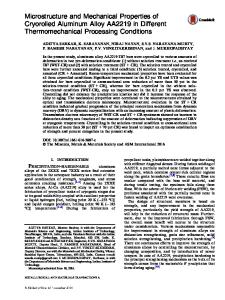Effects of thermomechanical processing on the microstructure and mechanical properties of a Ti-V-N steel
- PDF / 5,436,580 Bytes
- 14 Pages / 613 x 788.28 pts Page_size
- 79 Downloads / 362 Views
I.
INTRODUCTION
A N important feature of microalloyed steels is the wide range of microstructures which can be obtained by varying the steel composition and the thermomechanical treatment. The specific effects of individual microstructural components (e.g., grain size, precipitates, dislocation substructure, carbides, inclusions, texture) on strength and toughness of controlled-rolled microalloyed steels have been widely studied. I11 The strengthening mechanisms are quite well understood, but the effects of microstructure on brittle fracture are less clear. It is known that large ferrite grain size, brittle phases, large volume fractions of precipitates, high dislocation densities, ferrite texture, and dissolved nitrogen all can contribute to cleavage fracture.t2] However, the relative importance of these factors in the complex microstructures found in microalloyed steels is not known. Studies of cleavage fracture in these steels have emphasized to varying degrees the roles of ferrite grains,t3"41low temperature transformation products (LTTP) such as bainite or martensite, r51 the interface between ferrite and LTTP, I6j or other brittle phases (e.g., Fe3C). I71Also, the role of inclusions in cleavage initiation requires clarification.t81 Microstructures of interest are those produced by commercial plate rolling, including accelerated cooling after rolling. There are three basic types of rolling schedules: (i) "recrystallization rolling" - - austenite grains fully recrystallize between passes, and are progressively refined during rolling to as small as 20 ].s 19] (ii) "controlled rolling" --considerable reduction takes place below the austenite recrystallization-stop temperature, austenite grains are elongated and reduced in width ("pancaked"), and the effective spacing of ferrite nucleation sites (austenite grain boundaries and deformation bands) can be 5 to 10/zm; (iii) "intercritical rolling"-- finishing passes are in the a + 3~phase field, B. DOGAN, formerly with CANMET, Ottawa, Canada, is a Research Scientist with GKSS Forschungszentrum Geesthacht GmbH, Max-PlanckStrasse, D-2054 Geesthacht, Federal Republic of Germany. L. E. COLLINS and J. D. BOYD are Research Scientists with the Physical Metallurgy Research Laboratories, CANMET, 568 Booth Street, Ottawa, ON, Canada, K1A 0G1. Manuscript submitted March 20, 1987. METALLURGICAL TRANSACTIONS A
ferrite progressively forms and is deformed, and the untransformed austenite is heavily deformed, resulting in a fine microstructure ( - 1 / x m subgrain size) having highly directional properties, tl~ Accelerated cooling after rolling generally refines the microstructure, and produces uniform distributions of low-temperature transformation products, which have excellent combinations of strength and toughness, till The present study had two parts. First, a single steel composition was selected and its austenite deformation behavior and continuous-cooling-transformation characteristics were determined. This information was used to design rolling schedules, representative o
Data Loading...











